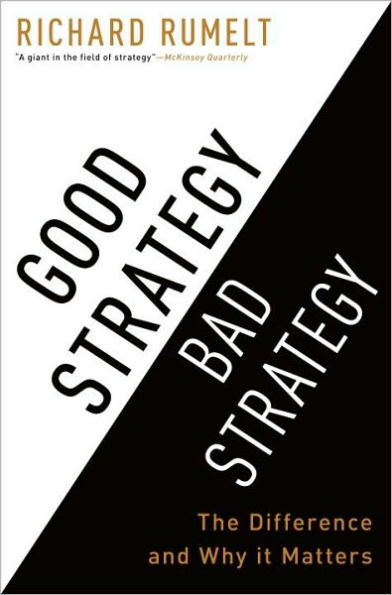Good Strategy/Bad Strategy clarifies the muddled thinking underlying too many strategies and provides a clear way to create and implement a powerful action-oriented strategy for the real world.
Developing and implementing a strategy is the central task of a leader. A good strategy is a specific and coherent response to—and approach for—overcoming the obstacles to progress. A good strategy works by harnessing and applying power where it will have the greatest effect. Yet, Rumelt shows that there has been a growing and unfortunate tendency to equate Mom-and-apple-pie values, fluffy packages of buzzwords, motivational slogans, and financial goals with “strategy.”
In Good Strategy/Bad Strategy, he debunks these elements of “bad strategy” and awakens an understanding of the power of a “good strategy.” He introduces nine sources of power—ranging from using leverage to effectively focusing on growth—that are eye-opening yet pragmatic tools that can easily be put to work on Monday morning, and uses fascinating examples from business, nonprofit, and military affairs to bring its original and pragmatic ideas to life. The detailed examples range from Apple to General Motors, from the two Iraq wars to Afghanistan, from a small local market to Wal-Mart, from Nvidia to Silicon Graphics, from the Getty Trust to the Los Angeles Unified School District, from Cisco Systems to Paccar, and from Global Crossing to the 2007–08 financial crisis.
Reflecting an astonishing grasp and integration of economics, finance, technology, history, and the brilliance and foibles of the human character, Good Strategy/Bad Strategy stems from Rumelt’s decades of digging beyond the superficial to address hard questions with honesty and integrity.
Good Strategy/Bad Strategy clarifies the muddled thinking underlying too many strategies and provides a clear way to create and implement a powerful action-oriented strategy for the real world.
Developing and implementing a strategy is the central task of a leader. A good strategy is a specific and coherent response to—and approach for—overcoming the obstacles to progress. A good strategy works by harnessing and applying power where it will have the greatest effect. Yet, Rumelt shows that there has been a growing and unfortunate tendency to equate Mom-and-apple-pie values, fluffy packages of buzzwords, motivational slogans, and financial goals with “strategy.”
In Good Strategy/Bad Strategy, he debunks these elements of “bad strategy” and awakens an understanding of the power of a “good strategy.” He introduces nine sources of power—ranging from using leverage to effectively focusing on growth—that are eye-opening yet pragmatic tools that can easily be put to work on Monday morning, and uses fascinating examples from business, nonprofit, and military affairs to bring its original and pragmatic ideas to life. The detailed examples range from Apple to General Motors, from the two Iraq wars to Afghanistan, from a small local market to Wal-Mart, from Nvidia to Silicon Graphics, from the Getty Trust to the Los Angeles Unified School District, from Cisco Systems to Paccar, and from Global Crossing to the 2007–08 financial crisis.
Reflecting an astonishing grasp and integration of economics, finance, technology, history, and the brilliance and foibles of the human character, Good Strategy/Bad Strategy stems from Rumelt’s decades of digging beyond the superficial to address hard questions with honesty and integrity.

Good Strategy Bad Strategy: The Difference and Why It Matters
336
Good Strategy Bad Strategy: The Difference and Why It Matters
336Hardcover
Related collections and offers

Product Details
| ISBN-13: | 9780307886231 |
|---|---|
| Publisher: | Crown Publishing Group |
| Publication date: | 07/19/2011 |
| Pages: | 336 |
| Product dimensions: | 6.60(w) x 9.40(h) x 1.00(d) |
About the Author
Customer Reviews
Explore More Items
"Christian, I've been yours since I said yes." I scoot forward, cupping his beloved face in my hands. "I'm yours. I will always be yours, husband of mine. Now, I think
"I rest my head against him, and he kisses my hair repeatedly. This is home. He smells of linen, fabric softener, bodywash, and my favorite smell—Christian. For a
"And in this quiet moment as I close my eyes, spent and sated, I think I'm in the eye of the storm. And in spite of all he's said,
How do we win a game that has no end?
The highly anticipated follow-up to the acclaimed bestseller Start With Why
Simon Sinek’s mission is to help people wake up every day inspired to go to work and return home every night
With this beautifully illustrated book of axioms Simon Sinek will inspire readers to overcome obstacles and become the leaders they wish they had. We'd achieve more if we chased the dream instead of
*More than 2.6 million copies sold
*One of The New York Times Book Review's ten best books of the year
*Selected by The Wall Street Journal as one of the best nonfiction
From the Nobel Prize-winning author of Thinking, Fast and Slow and the coauthor of Nudge, a revolutionary exploration of why people make bad
Dos médicos en la misma ciudad pueden dar diagnósticos diferentes
New York Times bestselling author Simon Sinek is an unshakable optimist and he wants to share that optimism. With this beautifully illustrated book he inspires readers to seek out a brighter future
A box appears and wonders who
“This brilliant book will shatter your assumptions about what it takes to improve and succeed. I wish I could go back in time and gift it to my younger self. It
